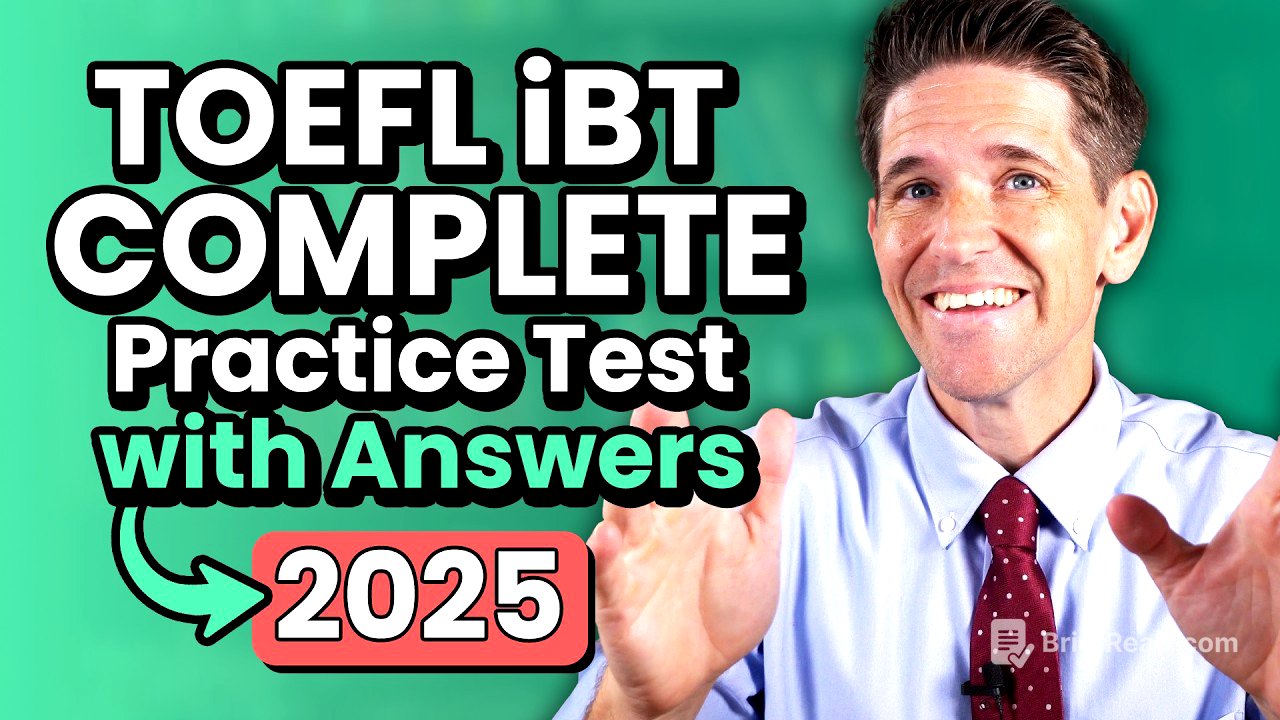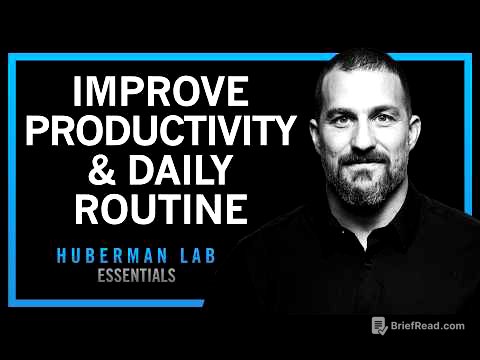TLDR;
This video presents a complete TOEFL IBT practice test, mirroring the actual test day experience with sections for reading, listening, speaking, and writing. It provides sample answers and explanations in a PDF format. The video also promotes the TOEFL emergency course, designed for quick and easy score improvement with essential tips, strategies, and study plans.
- Complete TOEFL IBT practice test
- Includes reading, listening, speaking and writing sections
- Sample answers and explanations available in PDF
- Promotion of TOEFL emergency course for rapid score improvement
Intro [0:00]
The video introduces a complete TOEFL IBT practice test, structured to replicate the actual test day experience. The test includes all four sections: reading, listening, speaking, and writing. Sample answers and detailed explanations are available in a PDF, accessible via a link in the description. The presenter wishes test-takers good luck, acknowledging the test's length and encouraging them to take their time.
TOEFL Reading Section Directions [0:38]
This section contains the directions for the reading part of the practice test.
Reading Passage 1 [0:44]
This section contains the first reading passage of the practice test.
Reading Passage 2 [18:30]
This section contains the second reading passage of the practice test.
TOEFL Listening Section Intro [36:13]
The listening section of the TOEFL IBT practice test is introduced, mirroring the format of the actual test. Test-takers will listen to passages, followed by questions. Answers and explanations are available via a PDF link in the description. The presenter highlights the importance of time management, reminding viewers that they control their time during the actual test. A shout-out is given to the TOEFL emergency course, designed to help students achieve their desired scores quickly through targeted tips, strategies, and study plans.
TOEFL Listening Section Directions [37:28]
This section contains the directions for the listening part of the practice test.
Listening Passage 1 [37:33]
A conversation takes place between a student, Jane, and Professor Jacobs. Jane discusses visiting an art exhibition and feeling inspired for her drip art project but also frustrated with expressing herself. The professor suggests she's experiencing the intended challenge of the assignment: stepping outside her comfort zone. He invites her to a drip art workshop on Saturday, where she can observe the process and ask questions.
Listening Passage 2 [42:51]
A lecture in an economics class discusses public goods, contrasting them with private goods like pizza. Public goods, such as basic cable channels and national defence, provide tremendous societal benefit without direct monetary return. Key characteristics of public goods include being non-excludable (difficult to prevent someone from using) and non-rivalrous (one person's use doesn't diminish availability for others). The lecture also touches on the challenge of funding public goods through mechanisms like taxes, ensuring everyone contributes.
Listening Passage 3 [51:03]
A psychology lecture discusses the case of Henry Molaison (HM), a significant figure in neuroscience. HM underwent brain surgery to alleviate severe epilepsy, which involved removing parts of his hippocampus and amygdala. While the surgery reduced his seizures, it resulted in severe anterograde amnesia, preventing him from forming new conscious memories. Despite this, HM's case provided unique insights into brain function, revealing that memory is not uniformly spread throughout the brain and that different systems exist for storing and retrieving memories, including muscle memory.
Listening Passage 4 [59:54]
A student approaches an IT worker with a problem: her laptop screen went blank and displayed strange symbols before shutting down. The IT worker suspects a virus and offers to scan the computer. Fortunately, the student had recently backed up her files. The IT worker explains that cleaning the hard drive might be necessary, potentially causing data loss. The student trusts the IT worker's judgement and leaves the computer for a scan, planning to use library computers to print her files in the meantime.
Listening Passage 5 [1:05:16]
A sociology class discusses marriage through different sociological perspectives. Functionalism views families as stabilising culture by fulfilling sexual, reproductive, and educational functions. Conflict theory sees society as a constant power struggle, highlighting individualistic tendencies in American families and power dynamics within households. Symbolic interactionism focuses on symbols and meanings, viewing family as a social construct that changes with time, place, and culture, with roles interpreted and acted out by family members.
TOEFL Speaking Section Directions [1:15:11]
This section contains the directions for the speaking part of the practice test.
TOEFL Speaking Question 1 [1:15:17]
The first speaking question asks whether teenagers should work while attending school to learn responsibility, requiring test-takers to provide details and examples to support their opinion.
TOEFL Speaking Question 2 [1:16:59]
The second speaking question involves reading a short passage and listening to a conversation about cafeteria meal plans, then expressing an opinion on the topic with supporting reasons.
TOEFL Speaking Question 3 [1:21:20]
The third speaking question requires reading a passage and listening to a lecture on leadership, then describing two types of leadership using examples from the lecture.
TOEFL Speaking Question 4 [1:25:57]
The fourth speaking question involves listening to a lecture in a psychology class and then describing two theories that explain why humans sleep, using points and examples from the talk.
Question 1 Sample Response [1:29:56]
The sample response agrees that teenagers should work to learn personal responsibility. The speaker shares their experience working as a custodian during high school, which taught them the value of hard work and education.
Question 2 Sample Response [1:30:44]
The sample response agrees with a letter advocating for more flexible school meal plans. The speaker likes to go to the cafeteria to hang out with friends. They would take advantage of a 50-meal plan if it were available. This option would satisfy students and increase school revenue without changing prices.
Question 3 Sample Response [1:31:44]
The sample response describes instrumental and expressive leadership styles. The speaker uses examples of a strict boss, Bill (instrumental leader), and a respectful professor, Green (expressive leader), to illustrate the two types of leaders.
Question 4 Sample Response [1:32:46]
The sample response describes two theories about why humans sleep. One theory suggests sleep restores resources used during the day, similar to hibernation. The other theory proposes sleep is an evolutionary adaptation to avoid nighttime predators.
TOEFL Writing Section Directions [1:33:46]
This section contains the directions for the writing part of the practice test.
TOEFL Writing Question 1 [1:33:55]
The integrated writing task involves reading a passage and listening to a lecture on the same topic, then summarising the lecture's points and explaining how they address specific problems presented in the reading passage. The reading passage discusses concerns about Earth's increasing population and potential scarcity of resources. The lecture counters this by highlighting increased awareness of biodiversity, technological advancements in water filtration and food production, and the decreasing cost of essential products.
TOEFL Writing Question 2 [1:59:55]
This section contains the second writing question of the practice test.









